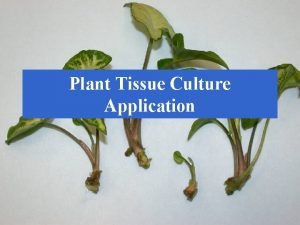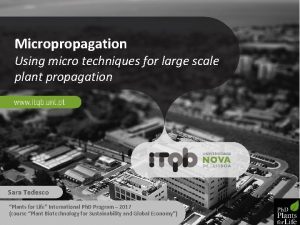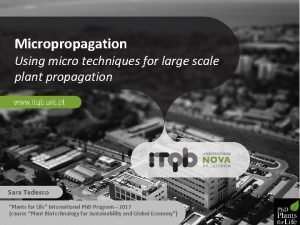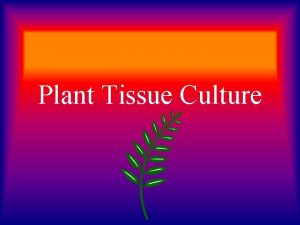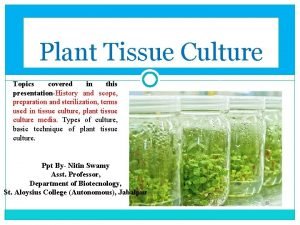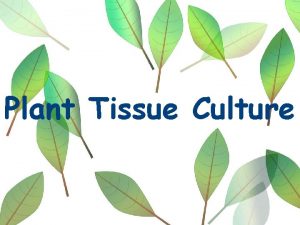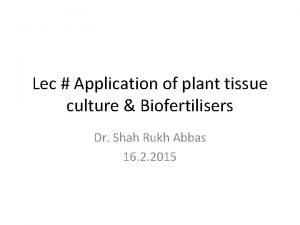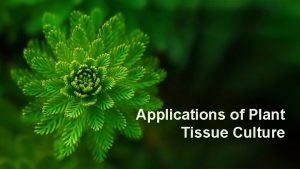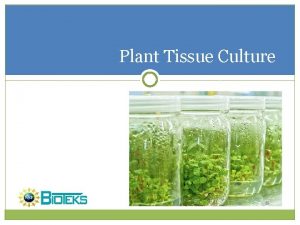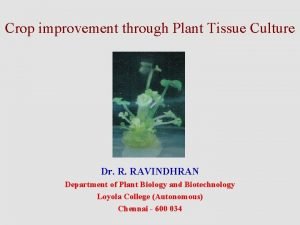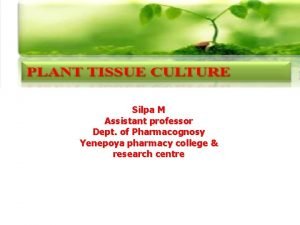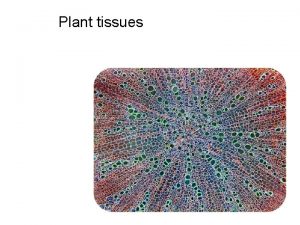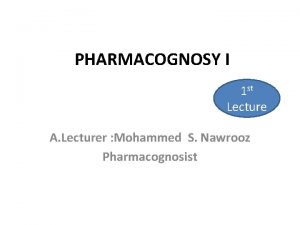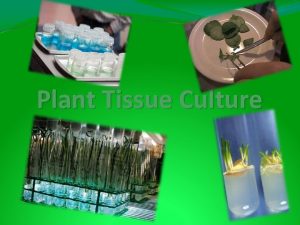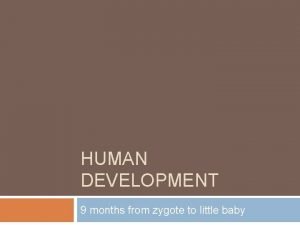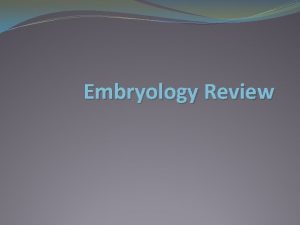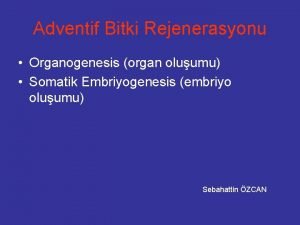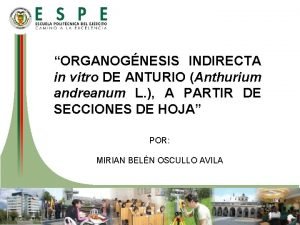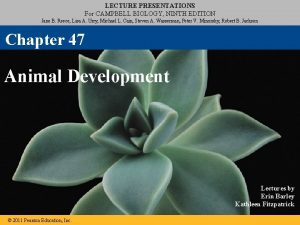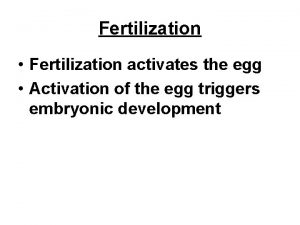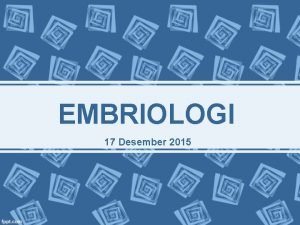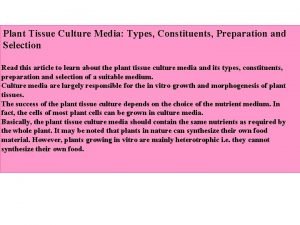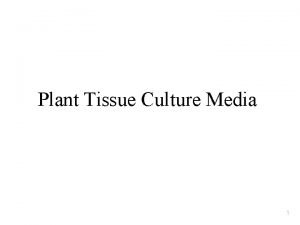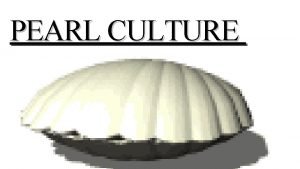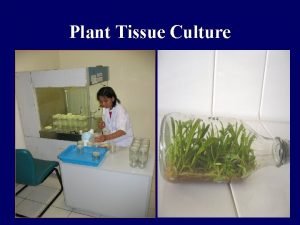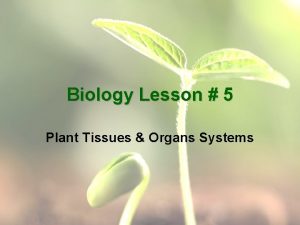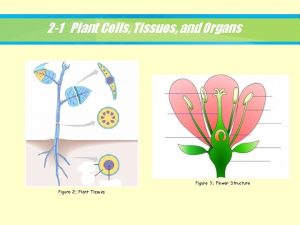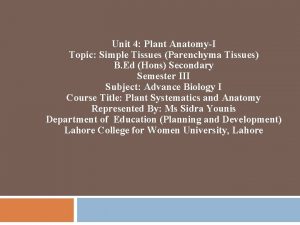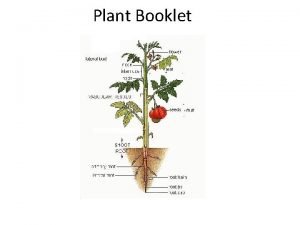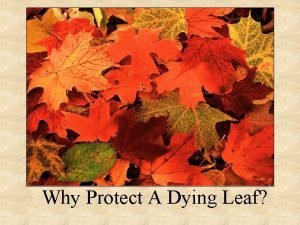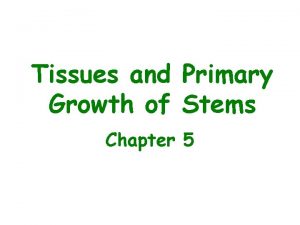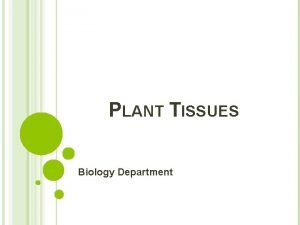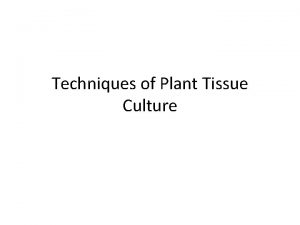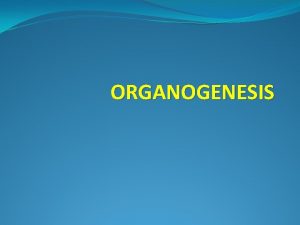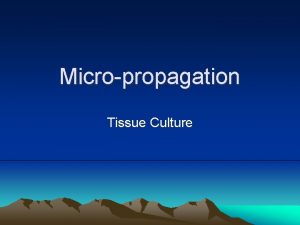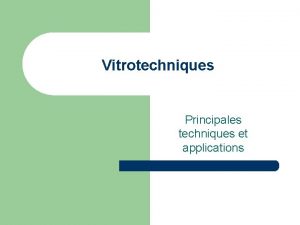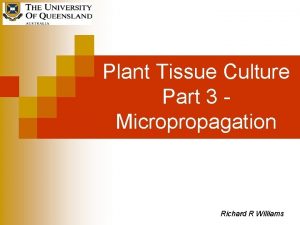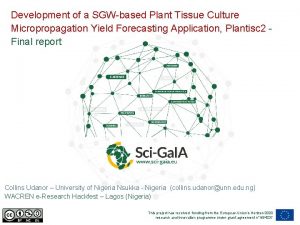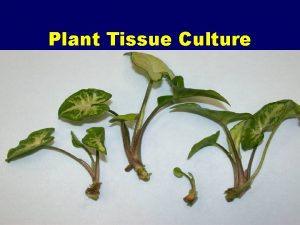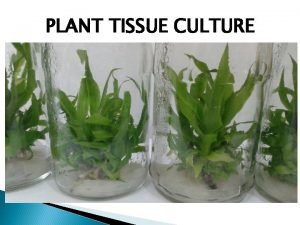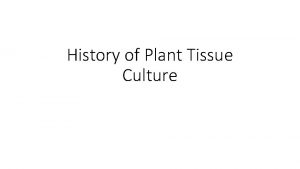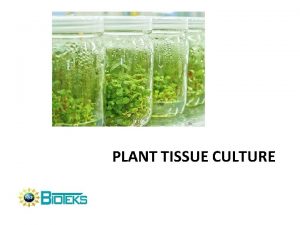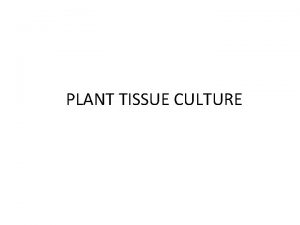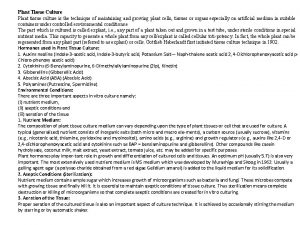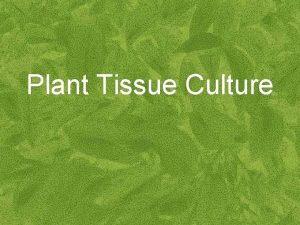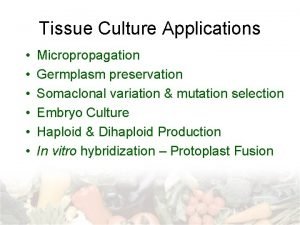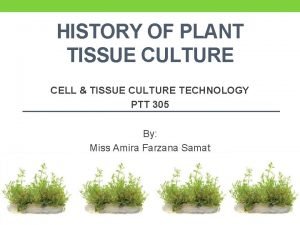Techniques of Plant Tissue Culture Callogenesis Organogenesis Micropropagation






































- Slides: 38

Techniques of Plant Tissue Culture

• • Callogenesis Organogenesis Micropropagation Somatic embryogenesis Cell Suspension Culture Anther Culture In Vitro Germplasm Conservation Secondary metabolite production

1)Callogenesis: Callus • It is a mass of undifferentiated parenchymatous cells. • An unorganized growth of plant cells in vitro on a culture medium is called callus. • Disorganized tumor like masses of plant cells that form in a culture, then proliferate in an irregular tissue masses and vary widely in texture, appearance and rate of growth.

Callogenesis • The process of callus formation is called callogenesis. • The cultivation of callus is generally occurred on solidified medium and initiated by inoculation of small explants or section from established organ. • Callus may be maintained indefinitely by regular sub culturing. • It may be used as the basis of • 1)Organogenesis 2)Cell suspension culture 3)Somatic embryogenesis

2) Organogenesis • The process of callus formation is called callogenesis. • The cultivation of callus is generally occurred on solidified medium and initiated by inoculation of small explants or section from established organ. • Callus may be maintained indefinitely by regular sub culturing. • It may be used as the basis of • 1)Organogenesis 2)Cell suspension culture 3)Somatic embryogenesis

Organ Culture • The maintenance or growth of organ primordia or whole parts of an organ in vitro in a way that allows differentiation and or preservation of its structure and or function.

3) Micropropagation • • Micropropagation or Clonal Multiplication Micro-Small Propagation-Multiplication 1)It can be called as in vitro propagation, especially in refrence to enhanced axillary branching or adventitious regeneration. • 2)It refers to propagation in culture by axillary and adventitious means. It is a general term for vegetative(asexual)in vitro propagation esometimes refererd to axillary bud proliferation

• In Nature--Two ways: 1: Sexual 2: asexual • Asexual Pro. gives rise the plants which are genetically identical to the parent plant and permits perpetuation of the unique characters of the cultivars. • Multiplication of genetically identical copies of a cultivar by asexual reproduction is called Clonal propagation.

• Clone: A population derived from a single individual by a. r is called Clone. • Example: seedless plants , Banana, Sugarcane, grape, fig, chrysynthemum, Turmeric, potato, etc. • In vivo clonal multiplication is v. difficult, expensive and season dependent. • .

4) Somatic Embryogenesis • Embryo formation from non sexual cells • Initiation and Development of embryos from somatic cells that is parallel to the developmental pathway of zygotic embryos • It is the process by which the somatic cells or tissues develop into differential embryos and each fully developed embryo is capable of developing into a plantlet.

Pathways of Embryogenesis • Direct from cultured explant e. g. , the organized structure of leaf, hypocotyls, stem, anthers and pollens and other parts • Indirect. From callus • From isolated cells i. e. , cell suspension cultures

From callus From isolated cells i. e. , cell suspension cultures • • • Proembryo Globular Heart shape Torpedo Bipolar embryo

5)Cell suspension culture The growing of cell in vitro, including the culture of single cell or small aggregats of cells in a liquid m edia. Cell= The smallest structural unit of an organism that is able to grow and reproduce independently Hberlandt 1902 developed the concept of cell culture Benefits= 1. S. C cultures provides an excellent opportunity to investigate the properties and potentialities of plant cell.

2. It also contributes our understanding of interrelationships and complementary influences of cells in multicellular organism. 3. Another aspect of the study was to describe the pathways of cellular organism. 4. The plant biotechnologist also recognized the merits of applying cell culture over an intact organ or whole plant culture to synthesize natural products. 5. It has great potential in crop improvement as free cell in culture permit quick administration and withdrawal of chemicals or different substances and making them easy targets of mutant selection.

6. The individual cells within a population shows cytogenetic and metabolic variation is termed. Spatial Heterogeneity. In this way cell line selection techniques can be usefully applied to produce high yielding cultures with superior agronomic traits. Isolation of single cell 1. From plant organs 2. From cultured tissues

6: Isolation and purification of protoplast • Protoplast : A cell whose cell wall has been removed or mechanically resulting in membrane Bounded cell.

• Isolation of protoplast 1. Mechanical is used occasionally. Vacoulated cells are used Merit=unknown effect of enzyme on prot. is not present. 2. Enzymatic • 3. Mixed enzymatic procedure

Sources of Protoplast 1. Isolation of prot. From leaves= Direct 2. Callus 3. cell suspension =Indirect

7)Protoplast fusion: • Protoplast = Cell with out wall----- • 1 - easy tools for under going fusion in vitro. • 2 - Incompatibility barriers do not exist during the cell fusion process at interspecific, intergenric or interkingdom level. • 3 - So it is the finest single cell system-------exciting possibilities in the field of somatic cell genetics + crop improvement.

• • • Types of fusion: 1 -Spontaneous fusion: 2 -Mechanical fusion: 3 -Induced fusion: 4: Electro fusion:

7)Anther Culture • • • Why we need this? Breeding programme typically require several years to • • develop a new variety. The process begins Male X Female (P 1) Cross pollination Hybrid F 1 • • • heterozygous but genetically uniform Self fertilized F 1 X F 1

• Segregation occurs : it is the separation of homologous chr at meiosis • Genetic variability within F 2 Population • Self pollination-homozygou-F 5 generation 97% • Following by initial cross pollination

What should be the alternate of this ? • Answer is Anther culture which provides a method for the production of homozygous lines over the course of a few months. • Haploid plants have gametophytic no. of chr. i. e. a single set of chr in sporophyte,

Importance • Answer is Anther culture which provides a method for the production of homozygous lines over the course of a few months. • Haploid plants have gametophytic no. of chr. i. e. a single set of chr in sporophyte,

Androgenesis • Development of haploid plants from the male gametophyte following a developmental pattern resembling embryogenesis, resulting from the culture of anthers or microspores.

Anther culture • Development of haploid plants from the male gametophyte following a developmental pattern resembling embryogenesis, resulting from the culture of anthers or microspores.

Techniques for androgenesis: – a) b) c) d) The requirement that trigger off andro. Are Healthy plants grown under controlled environmental conditions. Knowledge of pollen ontogenesis in the strain to be used Temperature treatment to arrest existing metabolism in order to shift it towards the new pathway of embryogenesis instead of the ususl formation of mature pollens. Once the androgenic embryos are formed their development into plants is dependent on the composition of culture medium , light and temperature conditions.

9)Germplasm Conservation • Germplasm is a term used to describe the genetic resources, or more precisely the DNA of an organism and collections of that material. • Conservation: The protection, preservation, management, or restoration of Germplasm. • Or it is the science of the protection and management of biodiversity. • It is an interdisciplinary science that aims to apply genetic methods to the conservation and restoration of biodiversity

Why Conservation • Primitive man ---seeds &vegetative p Ropagules ---for next season • History--- Chinese 700 BC PSRIMITIVE CULTIVARS &Their primitive relatives • Exploitation of resources—due to increase human pop. , for more food, • Replacement of wild crops by superior variety crops having improved agronomic characters.

• Industrilization and urbanization ----affect the ecosystem adversly. • 2000 -6000 higher plant sp. Became endangered • Relizing this factor UN CONF. held on 1972 --recomende. con. of habitats which are rich in g. resources • 1974—CGIAR established---IBPGR • IPGRI

• Objective: • the collection, conservation, and utilization of the plant genetic resources elsewhere in the world.

Modes of conservation • Principle: To preserve the maximum • Possible genetic diversity of a particular plant or genetic stock for future use. • Diversity of plant; • 1) Species • 2) Varieties • 3) Individuals • 4) Special genetic resources: mutant or breeder line with identified genes

• 1) In situ conservation • 2) Ex situ conservation

Modes of conservation 1. Slow growth system. 2. Cryo preservation 3. Selection of method depends upon the plant material to be used for storage. 1. Slow growth system Cultures grown under modified conditions Enabling them to be stored for longer periods before transfer to fresh medium constitute slow growth system. Modifications 1. temp. reduction 2. Manipulation of chemical constituent ( ABA or high sucrose content) in media

2. Cryopreservation cultures on zero metabolism state by subjectivity them to super low temp_ in the presence or absence of cryoprotectants. 1. In this technique plant material is frozen and maintained at the temp of liquid N 2 which is around -196 C or -150 C in the vapour phase 1975.

Application and limitation • 1. It is significant due to small no of workers involved. • 2. Only a few sp are recalcitrant to this method using cell culture. • 3. G. C using cell, tissues and organs culture has been reported in 60 sps including fruit trees, crops, monocot and dicot

• 4. Required little space as compared to hectares. • 5. Cryopreservation is most reliable apporch to long term preservation of c. cultures which posses the biosynthetic capacity for synthesis and accumulation of secondary metabolites.

Limitations: • 1. The expensive equipment needed to provide controlled and variable rates of cooling and warming temp. • 2. Low cost rate equipment for cooling must be developed. • 3. Distribution techniques and information network not to be developed.
 Disadvantages of cryopreservation
Disadvantages of cryopreservation Micropropagation
Micropropagation Plant tissue
Plant tissue Plant tissue culture terminology
Plant tissue culture terminology Plant tissue culture project topics
Plant tissue culture project topics Plant tissue culture definition
Plant tissue culture definition Advantage and disadvantage of biofertilizer ppt
Advantage and disadvantage of biofertilizer ppt Safina plants
Safina plants Applications of plant tissue culture in pharmacognosy
Applications of plant tissue culture in pharmacognosy Plant tissue culture
Plant tissue culture Application of plant tissue culture
Application of plant tissue culture Meristematic tissue flow chart
Meristematic tissue flow chart Scope of pharmacognosy
Scope of pharmacognosy Techniques of tissue culture
Techniques of tissue culture Morula
Morula Organogenesis timeline
Organogenesis timeline Organogenesis nedir
Organogenesis nedir Peta konsep pertumbuhan dan perkembangan
Peta konsep pertumbuhan dan perkembangan Organogenesis
Organogenesis Cortical reaction
Cortical reaction Sea urchin external fertilization
Sea urchin external fertilization Organogenesis adalah
Organogenesis adalah Jaringan epitel dapat ditemukan di
Jaringan epitel dapat ditemukan di Ms media preparation
Ms media preparation Auxin in tissue culture
Auxin in tissue culture Artificial pearl formation
Artificial pearl formation Orchid tissue culture media
Orchid tissue culture media Peta konsep materi struktur dan fungsi tumbuhan
Peta konsep materi struktur dan fungsi tumbuhan Plant tissue and organs
Plant tissue and organs Which tissue transports water around a plant?
Which tissue transports water around a plant? Which tissue transports water around a plant?
Which tissue transports water around a plant? Plant tissue and organs
Plant tissue and organs Plant tissue and organs
Plant tissue and organs Parenchyma
Parenchyma Plant tissue
Plant tissue Stratified cuboidal
Stratified cuboidal Collenchyma
Collenchyma Primary growth
Primary growth Sclerenchyma
Sclerenchyma
